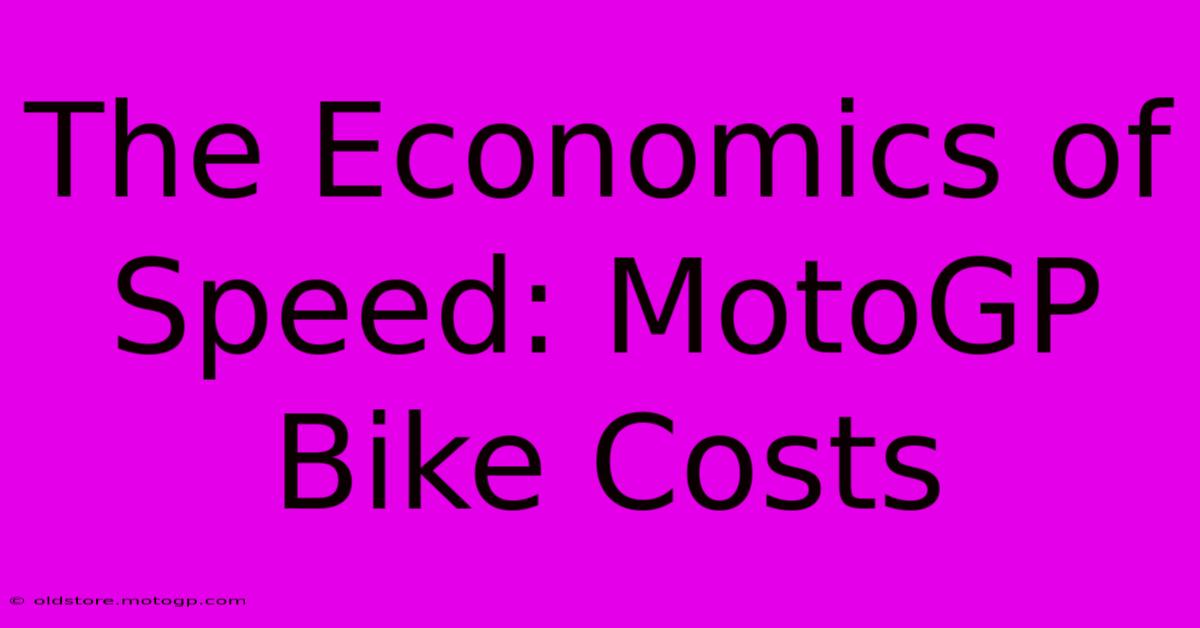The Economics Of Speed: MotoGP Bike Costs

Table of Contents
The Economics of Speed: MotoGP Bike Costs
MotoGP. The pinnacle of motorcycle racing. The roar of the engines, the breathtaking speeds, the nail-biting finishes – it's a spectacle that captivates millions. But beyond the glamour and the glory lies a complex world of high-stakes economics, and a significant part of that is the staggering cost of the machines themselves. This article delves into the financial landscape of MotoGP, focusing specifically on the exorbitant price tag of these technologically advanced racing bikes.
The Price Tag of Perfection: How Much Does a MotoGP Bike Cost?
There's no publicly available price list for a MotoGP bike. Unlike consumer motorcycles, these machines aren't sold to the public. They are meticulously crafted, bespoke pieces of engineering, built by the factory teams (such as Ducati, Yamaha, Honda, Aprilia, KTM, and Suzuki) specifically for the championship. This makes determining an exact price difficult. However, estimates place the cost of a single MotoGP prototype in the range of $2 million to $3 million USD. This is a substantial investment, even for these multi-million dollar teams.
Factors Inflating the Price:
Several factors contribute to this astronomical cost:
-
Advanced Materials: MotoGP bikes utilize cutting-edge materials like carbon fiber, titanium, and magnesium alloys. These materials are incredibly lightweight and strong, providing a crucial advantage in performance, but they come with a hefty price tag.
-
Sophisticated Electronics: Modern MotoGP bikes are packed with sophisticated electronics, including advanced traction control, engine mapping systems, and data acquisition units. The development and integration of these systems represent a significant investment in research and development (R&D).
-
Highly Skilled Labor: The construction of a MotoGP bike requires the expertise of highly skilled engineers, technicians, and mechanics. Their specialized knowledge and meticulous craftsmanship are reflected in the final cost.
-
Constant Development and Iteration: MotoGP is a relentless pursuit of improvement. Teams continuously develop and refine their machines throughout the season, incorporating learnings from races and testing sessions. This constant evolution translates to ongoing expenses for parts, materials, and labor.
-
Specialized Parts and Components: Many parts are custom-made and manufactured in small batches or even individually. This reduces economies of scale and increases the cost significantly.
Beyond the Initial Investment: Ongoing Costs
The initial price of the bike is only the tip of the iceberg. The ongoing operational costs are substantial and include:
-
Engine Development and Maintenance: MotoGP engines are incredibly powerful and highly stressed. They require frequent maintenance and are often rebuilt or replaced throughout a season.
-
Tire Costs: MotoGP teams consume a vast number of tires during a season. The high-performance tires needed to compete at the highest level contribute significantly to overall expenses.
-
Travel and Logistics: The MotoGP championship is a global event, requiring extensive international travel for teams, personnel, and equipment. These costs are substantial.
-
Personnel Costs: Teams employ large numbers of highly skilled engineers, mechanics, technicians, and support staff. Salaries and benefits for this highly specialized workforce are a significant expense.
-
Research and Development: The ongoing research and development into new materials, technologies, and racing strategies is a critical but costly element of MotoGP competition.
The Return on Investment: Sponsorship and Prize Money
Despite the astronomical costs, teams find ways to offset the expenses. Significant revenue comes from sponsorships and prize money. Major brands vie for the opportunity to associate with prestigious teams and the high-profile nature of MotoGP. Winning races and championships attracts further sponsorship opportunities, creating a positive feedback loop.
However, the financial risks are substantial. Failure to perform can severely impact a team's sponsorship prospects and overall profitability. The economic pressures within MotoGP are immense, necessitating efficient resource management and strategic decision-making to compete effectively.
Conclusion: A High-Stakes Game
The economics of MotoGP are complex, intertwined with technological advancement, intense competition, and substantial financial investment. While the precise cost of a single MotoGP bike remains elusive, the multi-million dollar figure is a testament to the sophisticated engineering and relentless pursuit of performance at the pinnacle of motorcycle racing. The high costs are balanced by the potential return from sponsorships, prize money, and the ultimate goal – achieving championship glory.

Thank you for visiting our website wich cover about The Economics Of Speed: MotoGP Bike Costs. We hope the information provided has been useful to you. Feel free to contact us if you have any questions or need further assistance. See you next time and dont miss to bookmark.
Featured Posts
-
Fake Motorcycle Helmets The Dangers You Should Know
Feb 22, 2025
-
Parking Rideshares And More Austin F1 Transportation Guide
Feb 22, 2025
-
Moto Gp Crash Today Will There Be Penalties
Feb 22, 2025
-
Fuel Your Racing Ambitions Explore Our Inventory
Feb 22, 2025
-
From Zero To Hero The Rise Of The Best Motorcyclist
Feb 22, 2025
